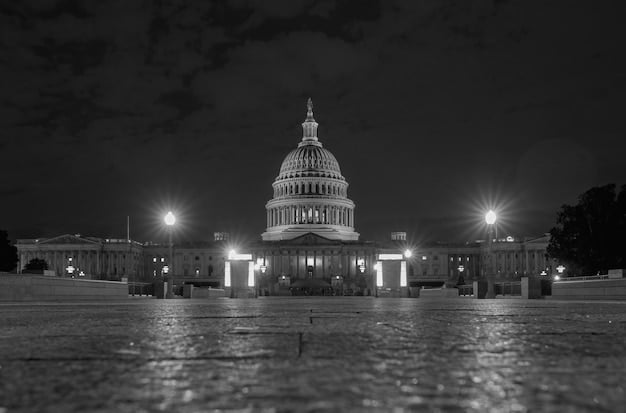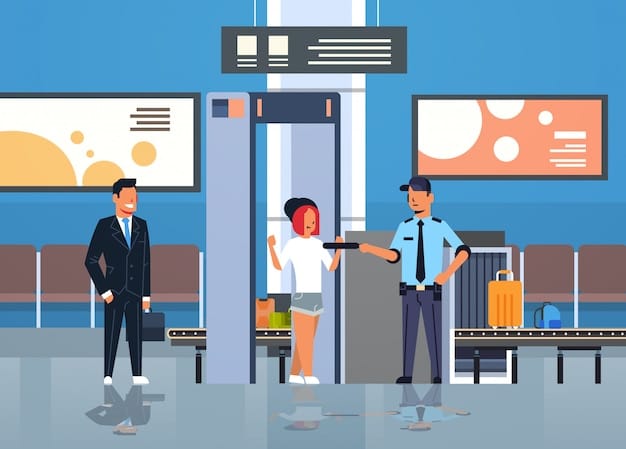Government Shutdown Consequences: Impact on Federal Services and the Economy

A government shutdown can lead to a spectrum of consequences, including the disruption of federal services, economic instability due to furloughed employees and reduced government spending, and potential long-term impacts on public trust and economic recovery.
A government shutdown, while often viewed as a political event, has far-reaching implications that affect various aspects of daily life and the national economy. Understanding what are the potential consequences of the government shutdown on federal services and the economy requires a close examination of the immediate disruptions and the long-term ripple effects.
Federal Service Disruptions During a Shutdown
One of the most immediate and visible impacts of a government shutdown is the disruption of federal services. When funding lapses, many government agencies are forced to scale back operations, leading to widespread consequences for citizens and the economy.
Essential vs. Non-Essential Services
During a shutdown, a key distinction is made between essential and non-essential services. Essential services, which are deemed necessary for the protection of life and property, typically continue to operate. However, non-essential services face significant disruptions.
Examples of Impacted Federal Agencies
Several federal agencies are commonly affected during a government shutdown. These include national parks, passport offices, and various regulatory bodies. The closure or reduced operation of these agencies can have direct impacts on individuals and businesses.
- National Parks: Closure of parks leads to loss of tourism revenue for local communities.
- Passport Offices: Delays in processing passport applications affect travel plans.
- Regulatory Bodies: Reduced oversight can lead to regulatory lapses and potential safety concerns.
The effect of these disruptions can extend beyond mere inconvenience, impacting economic activity and public safety. For example, delays in permit approvals can hinder construction projects, while reduced food safety inspections can raise health concerns.

Economic Consequences of Government Shutdowns
Beyond the disruption of federal services, a government shutdown can have significant economic consequences. These effects ripple through the economy, impacting everything from consumer confidence to business investments.
Impact on Federal Employees and Contractors
One of the direct economic impacts of a government shutdown is on federal employees and contractors. When government operations are suspended, many employees are furloughed, meaning they are temporarily laid off without pay. This loss of income can have significant financial repercussions for these individuals and their families.
Effects on GDP and Consumer Spending
Government shutdowns can negatively affect GDP and consumer spending. Furloughed employees reduce their spending, and the overall uncertainty created by the shutdown can dampen consumer confidence, leading to further reductions in spending.
- Reduced Consumer Spending: Furloughed employees and contractors cut back on discretionary spending.
- Business Uncertainty: Businesses delay investments due to economic uncertainty.
- Decreased GDP: Overall economic activity slows down, impacting GDP growth.
The severity of the economic impact depends on the duration of the shutdown and the extent of the disruption. Longer shutdowns can lead to more significant and lasting economic damage.
Impact on Public Health and Safety
A government shutdown can also have serious consequences for public health and safety. Reduced funding and staffing can impair essential services critical for maintaining public well-being.
Healthcare and Research
The healthcare sector is particularly vulnerable during a government shutdown. Agencies like the National Institutes of Health (NIH) and the Centers for Disease Control and Prevention (CDC) may face reduced capacity, leading to delays in research and public health initiatives.
Law Enforcement and Security
Law enforcement and security agencies are also affected, potentially compromising public safety. Reduced staffing at border control and airport security can create vulnerabilities and increase risks.

- Border Control: Reduced staffing can lead to slower processing and increased security risks.
- Airport Security: TSA delays can affect travel and security.
- Emergency Response: Delays in funding can impact emergency response capabilities.
The potential impacts on public health and safety underscore the importance of avoiding government shutdowns and maintaining consistent funding for critical services.
Long-Term Effects on Public Trust
Repeated government shutdowns can erode public trust in government institutions. The perception of instability and dysfunction can lead to cynicism and disengagement among citizens.
Erosion of Trust in Government Institutions
Frequent shutdowns contribute to a sense of instability and dysfunction, damaging public confidence in government. This can lead to decreased citizen engagement and a reluctance to support government initiatives.
Political Polarization and Gridlock
The political polarization and gridlock that often lead to shutdowns can further exacerbate the problem. When political parties are unable to compromise, the public loses faith in their ability to govern effectively.
Maintaining public trust requires consistent and reliable government operations. Avoiding shutdowns and fostering a culture of collaboration and compromise is crucial for restoring faith in government institutions.
Historical Examples of Government Shutdown Consequences
Looking at historical examples of government shutdowns provides valuable insights into the range and severity of potential consequences. These events illustrate the real-world impacts on federal services, the economy, and public trust.
The 2013 Shutdown
The 2013 government shutdown, lasting for 16 days, had significant impacts across various sectors. Federal employees were furloughed, national parks were closed, and economic activity slowed down. The shutdown cost the U.S. economy billions of dollars.
The 2018-2019 Shutdown
The 2018-2019 shutdown, which lasted for 35 days, was the longest in U.S. history. It affected numerous federal agencies, including the IRS and the Department of Homeland Security. The shutdown led to significant disruptions in tax processing, border security, and air travel.
These historical examples highlight the diverse and far-reaching consequences of government shutdowns. They serve as a reminder of the importance of responsible governance and the need to avoid these disruptive events.
Mitigating the Consequences of Government Shutdowns
While preventing a government shutdown is the ideal solution, there are strategies that can mitigate the potential consequences. These include contingency planning, prioritizing essential services, and fostering bipartisan cooperation.
Contingency Planning and Preparedness
Government agencies can develop contingency plans to ensure that essential services continue to operate during a shutdown. These plans should identify critical functions and allocate resources accordingly.
Prioritizing Essential Services
Prioritizing essential services is crucial for minimizing the impact on public health and safety. This involves ensuring that critical functions, such as law enforcement, emergency response, and healthcare, continue to operate without interruption.
Fostering Bipartisan Cooperation
Ultimately, avoiding government shutdowns requires bipartisan cooperation and a willingness to compromise. Political leaders must work together to find common ground and avoid the brinkmanship that often leads to shutdowns.
| Key Point | Brief Description |
|---|---|
| 🚧 Service Disruptions | Federal services face shutdowns, affecting national parks and passport offices. |
| 📉 Economic Impact | Furloughed employees reduce spending, hitting GDP and consumer confidence. |
| 🚨 Public Safety | Healthcare and law enforcement face cuts, risking public safety and health. |
| 🏛️ Public Trust | Repeated shutdowns erode trust, leading to cynicism and disengagement. |
FAQ
▼
During a government shutdown, non-essential federal services are typically affected. This includes national parks, passport offices, and some regulatory agencies, leading to closures or reduced operations. Essential services, like law enforcement, continue.
▼
Federal employees deemed non-essential are often furloughed, meaning they are temporarily laid off without pay. This impacts their income and can affect their ability to meet financial obligations. Essential employees continue working, sometimes without immediate pay.
▼
A government shutdown can negatively impact GDP, reduce consumer spending, and create business uncertainty. Furloughed employees cut back on discretionary spending, and delayed government payments can disrupt economic activity. Longer shutdowns can lead to more severe economic damage.
▼
Shutdowns can reduce the capacity of healthcare and law enforcement agencies. Delays in research at the NIH and the CDC, reduced TSA staffing, and border control slowdowns can compromise public health and safety, creating vulnerabilities.
▼
Strategies include contingency planning by government agencies, prioritizing essential services, and fostering bipartisan cooperation to avoid shutdowns altogether. Contingency plans ensure critical functions continue operating, minimizing disruptions to public well-being and the economy.
Conclusion
In conclusion, **what are the potential consequences of the government shutdown on federal services and the economy** encompasses a broad spectrum of disruptions and impacts. From immediate service interruptions and economic instability to long-term effects on public trust, the consequences are far-reaching and underscore the importance of proactive measures to prevent such shutdowns. By understanding these potential outcomes, policymakers and citizens alike can work towards fostering responsible governance and ensuring stability in the face of political challenges.





